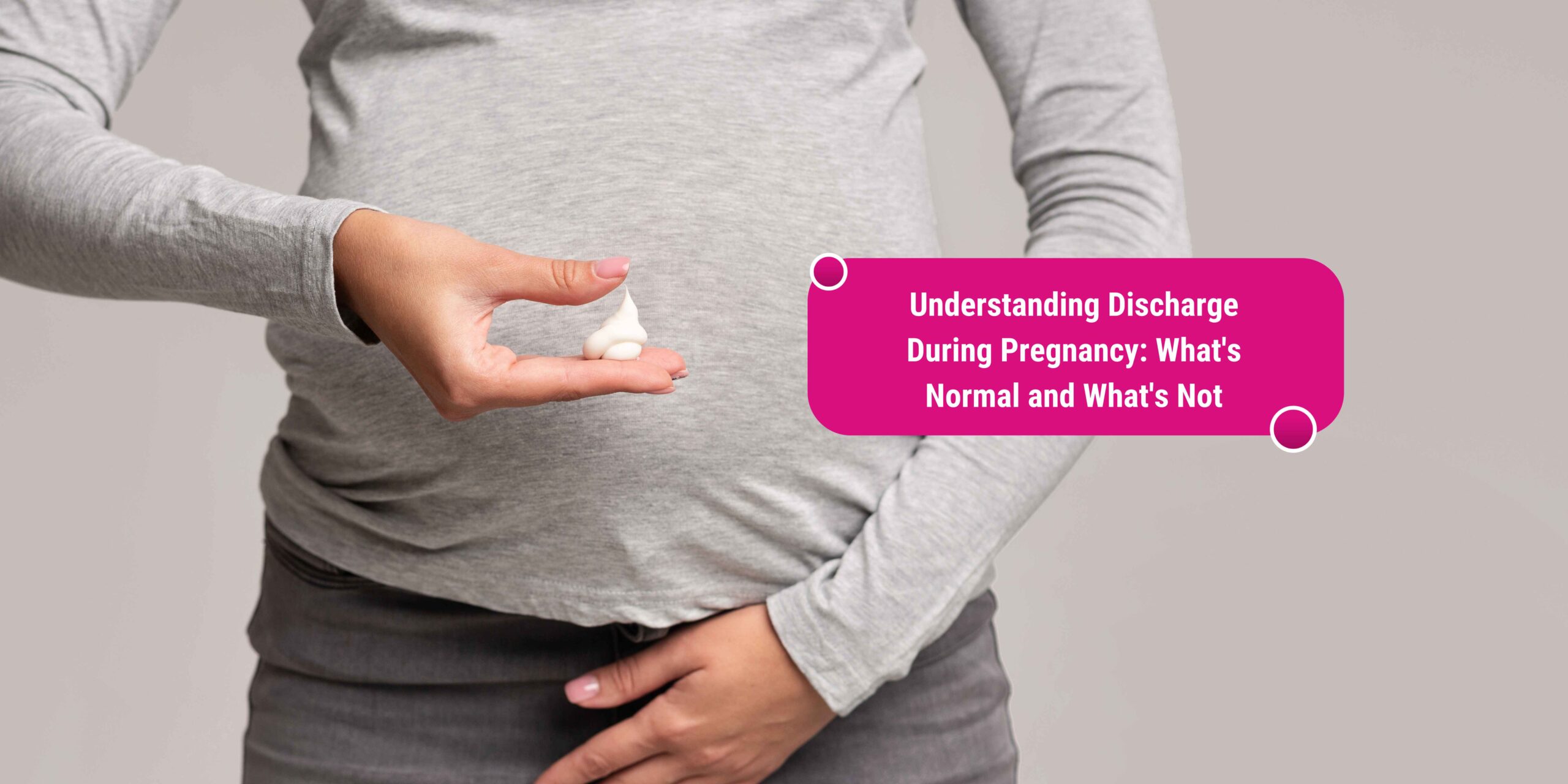Discharge is a general term used to describe the secretion or expulsion of fluid from a body part or an organ. Vaginal discharge is a type of discharge specific to all females. It may occur either naturally or from infections or sexually transmitted diseases. Vaginal discharge refers to a liquid substance produced by glands in the genital organs to keep moist and clean, and shape a favorable living environment for sperm and help the fertilization of the egg. When a female becomes pregnant, app notes that changes in the cervix, natural vaginal bacteria, or an increased vaginal blood flow brings increased vaginal discharge from the cervix throughout pregnancy. However, are there any differences between the discharge changes in different pregnancies? What are normal or abnormal in vaginal discharge during pregnancy? And what are the impacts on the pregnant women or the fetus if the increase or decrease in vaginal discharge during pregnancy?
Vaginal discharge may increase because the cervix has more mucus or as a result of an infection, such as a yeast infection. Therefore, some increased vaginal discharge in pregnancy is normal. Vaginal discharge may also indicate bacterial vaginosis, either a return of it or something new. A vaginal discharge that is getting heavier or thinning to look like water suggests placental abruption, which is a very serious problem. Vaginal discharge during pregnancy is an unusually common problem. Many women find it hard to know what amount of vaginal discharge is normal and when it may indicate a condition that needs medical attention. Normal vaginal discharge during pregnancy is called leukorrhea and is thin, white, milky, and mild-smelling. While not all pregnant women experience leukorrhea, it is one of the pregnancy symptoms. These changes to the cervical mucus result from hormone fluctuations. Hormone levels will surge even higher, which signals the body to produce more cervical mucus. This discharge is the body’s way of protecting the birth canal against infections. However, some women may have increased discharge in pregnancy due to an infection or other abnormal reasons.
Importance of Understanding Discharge During Pregnancy
Experiencing discharge during pregnancy is quite common; in fact, the majority of pregnant women will experience an increase in discharge. It is the body’s way of protecting the birth canal and the baby during pregnancy. Normal pregnancy discharge tends to be thin, mild smelling, and milky or creamy colored. Changes in color or texture and increased irritation are signs that there may be an issue. Counseling women about the physiological changes of normal vaginal discharge and explaining that an increase in vaginal discharge is common during pregnancy and is often a signal of a healthy pregnancy is very important. While many women may be aware of discharge as a sign of pregnancy, they are not often educated about the different kinds and what each can mean. Because discharge may also indicate infection or other pathology, it is important that women who have complaints about discharge be assessed and treated appropriately.
Some women or family members may become concerned if very little discharge is present, believing that this could be a sign that the baby has passed away. In order to be able to respond and help allay these fears, and to be able to appropriately assess and treat the variety of causes of increased discharge, it is imperative that all providers who care for pregnant patients be knowledgeable about the physiologic changes of pregnancy discharge, normal appearance, and normal odors.
Normal Discharge During Pregnancy
As you may have guessed, the primary cause of discharge during pregnancy is the pregnancy itself. The hormonal changes in a woman’s body, specifically estrogen and progesterone, have a big impact on the uterus and cervix, and therefore on what comes out of a pregnant vagina. A good portion of the discharge that comes out of a woman during pregnancy, no matter when it happens, is nothing more than old cells from the cervix. The physical and chemical changes of pregnancy can cause the cervix to contain more of these naturally exfoliating cells, so it’s understandable that a pregnant woman would see an increase in discharge.
A normal pregnant discharge, as the previous paragraph suggests, will appear more often, be less uniform, be thicker in consistency, and come in shades that range from clear to white or yellow. This kind of discharge may or may not have a slight odor, similar to the scent of the traditional body smell that most women are magnificently able to camouflage. If the discharge tends to be thinner and shows a faint pink or brown color, it may be blood or have some blood in it, and occasionally blood can hint in the direction of a health problem.
Characteristics of Normal Vaginal Discharge

Mucous-like, or “normal” vaginal discharge probably provides an anti-infective function. This discharge is generally thin, clear or milky in color, and has only a mild odor. It is of fairly constant volume and usually requires no thought or effort on the woman’s part. However, factors like sexual stimulation, medical examinations, and conditions like tension, stress, and anxiety can dramatically change the discharge characteristics found in a “normal” woman. A healthy woman’s normal discharge may also show some mild form of cyclical variation in character.
Discharge volume may increase some, typically to 1 to 3 ml/day. The volume of discharge will generally be in a consistent range (for the woman) day after day and over periods of months. These small cyclical differences in typical volume may be a result of normal, female hormones. Additionally, the amount of luteinizing hormone (LH) at ovulation has also been related to the amount of a woman’s discharge over several days of her cycle. However, even if you chart the onset of discharge or characteristics of change, a woman may not have an identifiable mucous-like discharge problem unless she reaches the stage when her discharge is suitable for fertilization by sperm.
Abnormal Discharge During Pregnancy
If you notice changes in the amount, texture, or smell of your discharge, it could be a sign of vaginitis, a common infection of the vagina. The most common kinds of vaginitis are bacterial vaginosis and yeast (candida) infections. Both are common conditions that are easily treated. Symptoms include changes in the color, odor, or amount of discharge, usually accompanied by itching and irritation. Recurring infections might be brought on by something topical, like bubble baths, lotions, or clothes made of synthetic fibers. If this is your first experience with such symptoms, you might want to visit a doctor to see what you can do to help prevent it from happening again.
One of the main concerns for pregnant women with vaginitis is that it can cause complications in their pregnancies. If you’re pregnant, don’t dawdle if there’s a change in the color, smell, or texture of the discharge. Use unscented cleansers only and don’t douche – the vagina is self-cleaning and douching will disrupt the natural balance of bacteria, which protects against infections. These secondary infections could be the cause of your sudden abundance of discharge. If you ever find that your vaginal area is itchy or painful during your pregnancy, it’s usually safe to treat it. You can use over-the-counter yeast infection treatments, but don’t forget to call your healthcare provider first so she can recommend the best treatment for you. Also, be sure to get plenty of rest, eat a well-balanced diet, and drink plenty of fluids. Drink only water, however, if you are prone to yeast infections. Try to avoid frequent or prolonged use of panty liners and sanitary pads, as they hold in heat and moisture. Keep your genital area clean and dry by wearing loose-fitting clothes made of natural fibers, which allow air through.
Causes of Abnormal Discharge
What causes an abnormal discharge? Women often worry, without realizing that some discharge is normal. Here is a list of abnormal discharges and their causes:
Bacteria are the most common cause of abnormal discharge. Most women don’t think it’s possible to have bacteria in their vagina—especially if there are no other symptoms—but many can and experience no adverse effects. If, however, there is a neutral pH, it could result in BV. These organisms then multiply and grow, leading to overgrowth in the vaginal lining and abnormal discharge which can have a strong fishy odor. Bacterial Vaginosis (BV) is a cause of clear, yellow discharge with a foul odor.
Candida is a significant cause of significant discharge, irritation, and exaggerated itching. Many women will experience vaginal yeast infections at some point in their life, and these infections are usually due to Candida. This is a thick, white, gritty discharge, and it is obvious to most women what it is. Although most women don’t realize the vagina does naturally have a rich yeast tissue which, under the right conditions, can lead to yeast infections. During pregnancy, the hormonal changes, including the increase in hormones from the placenta, can lead to an increase in yeast and the likelihood of Candida overgrowth. A thick, white, gritty discharge is a common symptom.
When to Seek Medical Help
During pregnancy, watery discharge feels like urine. In some cases, it may be difficult to differentiate watery discharge during pregnancy from urine or amniotic fluid. If this occurs, the pregnant woman should use a liner and change it often. Distinguishing between watery discharge during pregnancy and urine is critical. Watery discharge may be mistaken for urine, especially when it is associated with a bad odor and discomfort. If the pregnant woman’s water has broken, watery discharge will continue to gush from the vagina, whereas urine will cease as long as she is not pressed on the bladder. If watery discharge during pregnancy is scant and clear, it is typically normal. Pregnant women should contact their doctor to check for signs of amniotic fluid.
Furthermore, numerous studies have found that the cervix excretes more watery discharge during pregnancy than when a woman is not pregnant. Bacteria and other microorganisms excrete a fatty acid and other toxins that cause a smelly odor if the watery discharge during pregnancy is not white and has no burnt odor. In the vagina, bacteria are also present. Furthermore, it’s worth noting that fever, chills, a smell like fish, abnormal vaginal bleeding, and abdominal pain can all be symptoms of genital infections. Get tested for trichomoniasis, which needs aggressive treatment, if the watery discharge is itchy and gray, white, green, or yellow and bubbly. The amount of watery discharge during pregnancy that a woman excretes often increases when the baby’s due date approaches. According to research published in the International Journal of Gynecology & Obstetrics, even if the patient is unmarried and a qualified gynecologist is present, 10% of women in labor were incorrectly diagnosed as having the fluid that surrounded the baby’s head. The continuation of watery discharge from the vagina is one of the primary signs of water breakage.
Signs and Symptoms Requiring Immediate Attention
A mucous straining or discharge, blood clots, clotty or stringy discharge noted from the vaginal vault independently of cervical status, fresh red discharge without cervical changes, or any signs of an impending miscarriage are signs that must be positively documented and immediately evaluated regardless of gestational age. A placental abruption typically presents with acute onset of intense abdominal pain with dark red vaginal bleeding, usually without passage of clots or tissue. Disruptive events most frequently occur in the last trimester of pregnancy. If a patient is being managed expectantly and reports any sign of labor, membrane rupture, or heavy menstrual-like cramping or low back pain, evaluation should be expedited. Uterine cramping is felt by the patient as pain emanating from the uterine fundus which then radiates to the lower uterine segment, the pelvis, and the lower back. These are often the initial symptoms of labor that is occurring before there is any noticeable cervical change and may occur for days to weeks before progress to cervical change is noted. Uterine contractions are synchronously associated with cervical change and typically cause discomfort only in the lower pelvis. Symptoms of back pain can indicate a posterior fetus, and sub-optimal adjustment of the fetus’ position can lead to difficulty with vaginal delivery. Any woman at term should be evaluated for cervical dilation.
Preventive Measures
Leg elevation while resting, separate dietary measures from measures that interfere with the health of the pregnant. Combine dietary measures with urinary frequency measures. Provide water during the rest periods. During sleep, keep the leg extended out from the body using pillows (each knee and one of your shoulder pads). The need arises that resting apart be attending and we will never be able to put two pillows up as we want but as far as you can. If on a day of rest the varicose patient feels that she has swollen a lot, rest again. That is, do what feel best for all of here. Always have a lifestyle in favor of a balanced diet, maintain shape and not gain excess weight. The overall measures have a greater significance.
Always have an adequate healthy lifestyle. It continues to be essential for pregnant women to engage in some regular physical activity during pregnancy, and although varicose vein diseases are aggravated by high impact exercise, a regular low-impact walking program can be used. You avoid walking, jogging and training, even swimming and cycling. Under the advice of your attending healthcare professional, do what is best for some. You can also sign up for relaxation classes. Always have the following care in the hygienic part: use a cleansing soap that helps you to maintain healthy skin flora. Be attentive to the direction of the cane on the perianal region so that there is no appearance of the same. Make circular massages in the vulvar region to increase local circulation and freshen up the perineal.
Mainly in the matter of a gene maternity dialog, rest but the physical, always maintain two lifestyles: Switch between health and color care. The meaning of talking about lifestyles when you mention exercising while pregnant, but that we have a balance on our physical structure and appearance, it is essential that we segment the following text. Always have an adequate healthy lifestyle. It continues to be essential for pregnant women to engage in some regular physical activity during pregnancy, and although varicose vein diseases are aggravated by high impact exercise, a regular low-impact walking program can be used. You avoid walking, jogging and training, even swimming and cycling. Under the advice of your attending healthcare professional, do what is best for some. You can also sign up for relaxation classes. Always have the following care in the hygienic part: use a cleansing soap that helps you to maintain healthy skin flora. Be attentive to the direction of the cane on the perianal region so that there is no appearance of the same. Make circular massages in the vulvar region to increase local circulation and freshen up the perineal.
Tips for Maintaining Vaginal Health During Pregnancy
There’s really no mystery about how to take good care of the vaginal area during pregnancy. Keep it clean, and that means washing with mild soap and water during your daily bath or shower. That’s about it! Really. If you like, you can blot yourself dry after washing, but there’s really no need to do this to prevent harm. Don’t douche! This single piece of advice should be the single most important in the entire chapter, so if you’re in a hurry, take note and call it a day. I don’t mean to be crude, but douching is about the most inappropriate, most destructive and generally stupidest ways of coping with vaginal discharge that anyone has devised, and if that makes you curious about whom I really want to say, you either a) don’t have a douching habit you need to get rid of, or b) have not previously taken note of guidelines for menstrual hygiene.



